All about Emblica natural and vegetable hair colours
Colour your hair permanently and enjoy unparalleled shine, volume and care with plant-based hair colours. Only thanks to the power of nature.
In our shop, we offer Emblica® hair dyes, developed by the Bleu Vert company. Colour and care for your hair with truly natural colour pigments and active ingredients. All of these vegetable dyes are controlled for harmful ingredients and undergo regular and strict controls in competent and independent laboratories.
None of these vegetable dyes contain preservatives, colour enhancers, peroxide or other chemical additives, because your health and safety is at the heart of Bleu Vert's concerns.
Thanks to a particularly careful preparation and a superior quality, these vegetable dyes colour with more intensity than all the vegetable dyes you have known until now. Take this into account when you apply these vegetable dyes for the first time.
The difference between chemical and vegetable hair dyes

A chemical dye opens the hair scales, penetrates the hair fibre and bleaches the hair by peroxidation. The natural colour disappears, the hair is depigmented and lightened to the point of becoming completely white. Then, a succession of chemical reactions takes place inside the hair fibre: this is the re-pigmentation. It is this step that gives the hair its new colour. This method is aggressive because the hair must lose its structure to allow the chemical reaction to take place. It is denatured. In the case of repeated chemical colouring, the hair scales close up less and less well. The hair is then weakened. It has a dark and dull appearance. The hair becomes dry, porous and brittle.
Unlike chemical dyes, vegetable dyes do not penetrate the hair fibre. Vegetable dyes are natural pigments that are extracted from various plants in nature. These pigments have a natural affinity for the keratin that makes up the hair and adhere firmly to the hair fibre. The colour does not penetrate the hair. It sheathes and coats it. The structure of the fibre therefore remains intact. In the long term, vegetable colours become real treatments that improve the quality of the hair. The more you use, the thicker and more resistant the hair becomes. It becomes more consistent to the touch and a feeling of volume appears. The hair, thus enveloped, is more resistant to stress and pollution. As vegetable hair dye is softer than chemical hair dye, the application time is a little longer. But as everyone knows ... everything that is good, takes time. The result is well worth the time. After a plant-based colour, the hair is coloured, cared for and respected.
mblica colours are combined with the natural colour of the hair. This is why the results differ from person to person. The more the hair is coloured with these dyes, the more intense the colour and the longer it lasts.
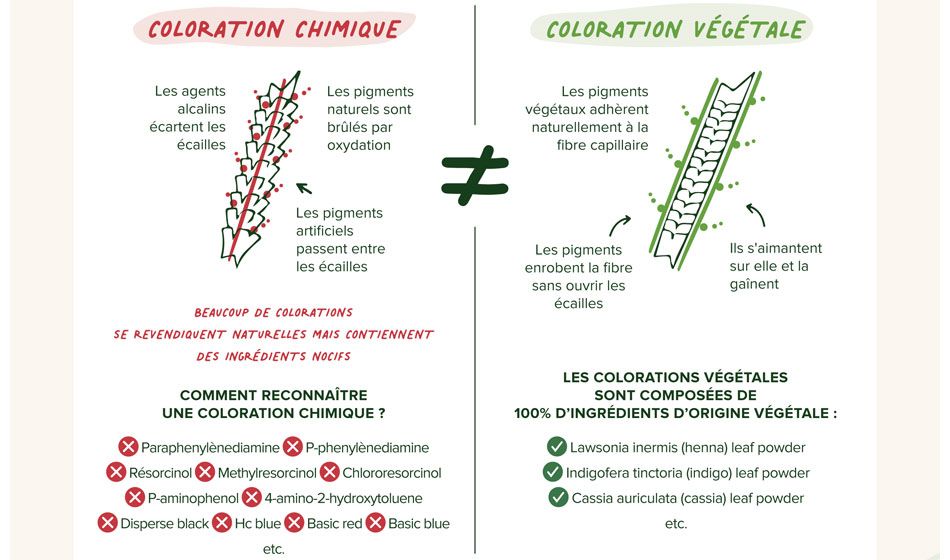
How do you colour Emblica vegetable dyes ?
These vegetable dyes dye your hair permanently. For this reason, we advise you to test the colouring with a strand of hair before the first application to avoid undesirable colour results.
For more information on this topic, please see the section on "Test colouring with a strand of hair before application".
The vegetable dyes coat each hair in the manner of a glaze. This means that the colour result depends essentially on your original colour, which gives rise to unique and individual highlights. Several successive applications intensify your colour.
With vegetable dyes, however, it is not possible to lighten the colour of your hair.
In order to colour the roots of your hair with the same intensity as your lengths, we recommend that you colour your roots with the chosen tone. As your lengths are already coloured, it is possible that they will be more intense in the long run than the roots, which will have been coloured less often.
Tips
You can safely mix all vegetable dyes together. The mixtures will depend on the desired result, but also on your hair type and your original colour.
Just as different hair types can be distinguished with the naked eye, so each hair can have a specific structure. There is straight and fine hair, but also curly hair, wavy hair and many others. Hair can be fine, normal or thick, healthy and shiny, but also very damaged. In addition to the natural characteristics of the hair, the type of care your hair has received so far is also important. Chemically treated hair, especially bleached hair, is usually very damaged, dry and brittle. Aggressed, split ends require special care.
Thus, damaged, possibly chemically treated and/or fine hair will be coloured more intensely than, for example, healthy, strong hair. If you are unsure about your hair type and the possible colouring of your hair, it is recommended that you start with a shorter application time after a strand test, as you are used to with the vegetable hair colour you have used so far.
Before application: test colour on a strand of hair !
In order to avoid undesirable results, we recommend that you do a colour test on a few strands of hair, especially before the first application of Emblica vegetable hair colour.
The trick is to take enough hair from your brush and apply a small amount of vegetable colouring mixed with water.
Place this coloured strand in a warm place. We recommend that you test different application times and remove the colour from the strands after 30, 60, 90 and 120 minutes. Rinse the strands carefully with warm water. Wait at least 24-48 hours before applying the hair colour to your hair to see how the colour develops on your hair. During this time, vegetable dyes may become stronger due to the influence of the air.
What you need for your vegetable colouring
Here are the accessories we recommend you gather for your colouring :
- A large enough bowl
- Hot water
- Gloves to protect your hands (provided in the box)
- An old towel to protect your clothes
- A brush for vegetable dyes
- A hairnet (provided in the box)
- A towel or woolen cap to keep the colouring warm
Optimal preparation of your hair
First, wash your hair with the right shampoo for your hair type. Note that many conventional products contain silicones. Silicone is deposited on each hair like a film and the hair initially appears shinier and healthier. However, over time, the hair is actually coated with silicone and is no longer able to receive care products or colouring because it acts as a barrier to the setting of the colour in the case of vegetable dyes. For this reason, be sure to use silicone-free products before applying Emblica vegetable dyes.
If you are not sure whether your hair care product contains silicone, we recommend washing your hair with ghassoul, for example, before applying Emblica hair colour.
Once prepared, your hair will take on the colour in the best possible way. Ideally, you should apply the hair colour to damp hair to ensure that the colour is evenly distributed.
Application protocol
SEVERAL STEPS TO BE RESPECTED FOR AN OPTIMAL RESULT
STEP 1 : Pour the powdered sachet into a large bowl and add 200 to 300 ml of warm water (40°C), mixing gently.
STEP 2 : After washing, divide the still wet hair into four sections and apply the colouring strand by strand in a thick layer.
STEP 3 : Couvrez les cheveux avec la charlotte, laissez poser la coloration entre 40 minutes et 90 minutes.
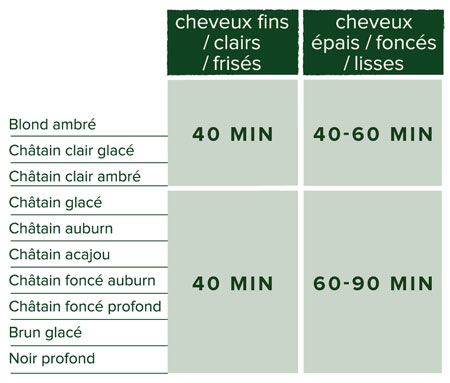
STEP 4 : Rinse the hair until the water runs clear
It is recommended to WAIT 48 HOURS BEFORE MAKING THE FIRST SHAMPOO AFTER COLOURING to allow the plant pigments to bind to the hair fibre.
Apply vegetable hair dye
Don't forget to protect your textiles as it is difficult, if not impossible, to remove stains. We also recommend that you always wear the gloves that come with the colouring, as the shades are very tenacious, especially on the nails.
Apply the warmest possible paste line by line, ideally with a colouring brush. Start at the roots and work your way down the length of the nails, parting by parting.
Spread the rest of the paste over the hair, massaging it in with your fingers. This will ensure an even result on your hair.
After applying the vegetable hair colour, put on a plastic cap to keep the colour warm. Make sure to cover the temples and the back of the neck. The hair colour must not dry out under any circumstances.
To keep the heat in, you can form a turban on your head with a towel (you can also put on a woollen cap, for example, which also keeps the heat in, or you can sit under an electric heat helmet).
The longer you keep the dough warm, the more intense the result will be.
Application time for natural hair colour
As mentioned above, the application time of your natural hair colour depends on the desired result and your hair type.
For the first application, leave the paste on for 40 minutes.
After colouring - how do I get the best hold ?
After the application time has elapsed, rinse your hair with lukewarm water until all colour residue has disappeared and the water is clear. Emblica vegetable dyes can be easily rinsed out with water only.
If possible, avoid washing your hair with shampoo or using styling products for 48 hours after colouring so that the colour will set better in the hair.
The next day, you can easily shampoo your hair.
Applying a hair oil will help the colour stay in place.
Massage a small amount of oil into your hair and scalp the day after colouring and leave it on for at least an hour (ideally overnight). Then wash your hair as usual with a shampoo.
Note that the colour may still darken a little.
If you are not satisfied with the result, opt for a longer or shorter application time for the next colour application, or mix the vegetable dyes together. There are no limits to your imagination.
Tips for optimum care - what you can add to your hair colour mixture
In rare cases, particularly damaged hair tends to dry out initially under the influence of vegetable dyes. This is due to the astringent effect of the vegetable dyes. You can compensate for this effect by adding a little silicone-free hair mask or conditioner to your paste.
Reduce the amount of water in your hair dye in favour of 1 to 2 teaspoons of a quality hair care product.
But avoid oils, or products that are very rich in oils, as they can prevent the colour from setting.
Root colouring
As mentioned above, it is likely that your lengths will become darker than the roots after several colourings, as the roots have received fewer layers than the rest of the hair. To avoid this colour discrepancy, it is recommended to colour only the roots.
Proceed with the preparations exactly as if you were colouring the whole hair.
Now separate your hair into different sections and hold them with clips. Proceed step by step through the different areas while removing the clips and applying the vegetable colouring section by section only to the first few centimetres of the root.
If you have an old application bottle, you can make the hair colour a little more fluid and fill your bottle. You may need to widen the spout of the bottle a little to make it easier for the paste to flow out of the bottle.
Again, the application time depends on the desired result and the structure of your hair.
Special advice for white hair
When using a particularly indigo rich vegetable colour (e.g. Emblica's Ice Chestnut 4.1, Deep Dark Chestnut 3.0, Ice Brown 2.1 and Deep Black 1.0), white hair can pick up green or blue highlights. Therefore, these shades should not be applied directly to your white hair to avoid undesirable colour results. To be on the safe side, we recommend testing a strand of hair.
It is also possible to colour your white or blond hair in these shades using the 2-step colouring process, as we will see in the next paragraph.
White hair : 2-step colouring
Emblica vegetable dyes are applied like a glaze around each hair. This means that the colour result is determined primarily by your natural hair colour and that there can also be a large difference in colour between your white hair and your pigmented hair.
The vegetable colouring Chestnut auburn 4.4 for Emblica has the property of adhering very easily to the hair. White hair can then fade very quickly, while other hair can become darker. This can cause undesirable contrasts.
In order to minimise this effect, it is therefore recommended that you colour your hair in two stages, especially if you have chosen a very dark shade. This way, the indigo will adhere better to your hair and you will get better hold, even on white hair.
First, colour your hair as described with Emblica Châtain auburn 4.4. The application time will depend on your hair structure, especially the thickness of your hair.
If your hair is now pre-coloured, you can now colour your hair with the darker shades and achieve an even result.
Answers to frequently asked questions (FAQ)
Can I lighten my hair with Emblica hair colour ?
Answer : The herbal recipes in our Emblica hair colours contain only Ayurvedic herbs and no oxidising agents, so it is not possible to lighten the hair. However, Emblica hair colours do add luminosity to the hair, which can give the impression of lightening.
Can I use Emblica vegetable hair colour during pregnancy or while breastfeeding ?
Answer : As our hair colours are 100% natural and free of essential oils, there are no contraindications to using our hair colours during pregnancy or while breastfeeding. However, we recommend that you carry out an allergy test 24 hours before colouring your hair to prevent any risk of reaction.
Can I use Emblica hair colour during chemotherapy ?
Answer : Our Emblica vegetable hair colours are harmless to your health thanks to their 100% natural and certified organic compositions. Nevertheless, chemotherapy can have an impact on the colour result which can be unpredictable. We invite you to carry out a preliminary test on a strand of hair to avoid any risk of undesirable effects.
Can I perm and colour my hair with Emblica hair colour ?
Answer : It is perfectly possible to perm your hair after colouring it naturally with Emblica hair colour. However, it is more beneficial to do your colouring after a perm because the colouring coats the hair and can reduce the hold of the perm. By colouring after the perm, you will be caring for hair that may have been weakened by the perm.
Can I use Emblica vegetable colouring on my eyebrows, beard, etc. ?
Answer : Our Emblica vegetable dyes are intended for hair colouring only and we do not recommend using them on other areas.
Are there any metallic salts or sodium picramate in Emblica plant dyes ?
Answer : Our Emblica plant recipes do not contain metallic salts or sodium picramate. Our organic certification ensures the absence of metallic salts and our recipes are regularly analysed by an independent laboratory to guarantee the highest level of safety and healthy formulas.
What precautions should I take before applying my Emblica plant-based hair colour ?
Answer : 1 - Protect your clothes
2 - Protect your hands with the gloves provided so as not to stain your hands and nails.
Although rare in vegetable hair dye, it is important to carry out an allergy alert test.
Apply the colour to a small, inconspicuous area of hair at the base of the head and leave on for 1.5 hours. If you feel a tingling sensation or itching, stop the application immediately and rinse thoroughly.
Does vegetable-based hair colouring fade ?
Answer : In principle, vegetable dyes are permanent colours. This is because the colour does not penetrate the hair fibre. This means that the colour pigments are only deposited on the outer part of the hair. Red tones in particular are very tenacious and only fade over time. How long the colour lasts will depend on how often you have already coloured your hair with vegetable dyes. Shades with a high percentage of indigo fade slightly faster.
How long should I wait between colouring ?
Réponse : There is no need to wait between colourings. But note that the colour can still develop between 24 and 48 hours after application. If you are not completely satisfied with the result, you should wait this long and then decide whether another colouring is necessary.
Is it possible to apply vegetable hair colour to permed hair ?
Answer : You can safely apply vegetable hair colour even on permed hair. You will notice the healing effect of the colour on chemically damaged hair. Even if you are perming hair that has been coloured with a vegetable dye, this is not a problem - although it may not hold as well and you may need to extend the application time. We recommend, however, that you go to a salon where competent professionals trained in vegetable dyes have acquired a good knowledge of vegetable dyes.
Can one develop intolerances or allergies when using vegetable dyes ?
Answer : Yes, even with vegetable dyes, intolerances and allergies can develop. Unfortunately, almost any natural or synthetic component can cause a reaction. If you suspect an intolerance, for example because you generally have a very allergic background, you should carry out an allergy test with your dermatologist. You can also carry out your own test by applying a small amount of diluted plant dye to an inconspicuous area of your hair. Leave it on for a maximum of 48 hours. Be careful, however, as small amounts of colour paste can cause intense colouring.
Can I safely mix all the colours together ?
Answer : All vegetable colours can be safely mixed together, allowing you to create your own personal and specific shade. There are no limits to your imagination. If you're not the type to take risks, test your shade mixes on strands of hair first.
The colour has become too red, too dark - what can I do ?
Answer : It's important to remember that vegetable dyes, because of their exceptionally high quality, have a strong colouring power and testing on strands of hair cannot be recommended enough. But if this happens and your hair has become too intensely coloured, there are several possibilities:
If the colour is too red, you can re-colour your hair with one of the vegetable dyes in the brown range. In this case, make sure that the application time is very short so as not to darken your hair too much (test on a strand of hair!).
If your colour turns out to be too dark, it will be more difficult to lighten your hair colour by one or two shades. In this case, you need to be patient. Since the indigo component (which allows you to go dark) in vegetable dye mixtures fades a little faster than the henna component (which allows you to go red), your colour will fade over time. It will eventually take on a redder shade.
Other methods are to apply regular hair care products that take much longer than the usual application times, including overnight. A mixture of honey, olive oil and lemon juice can also lighten your hair colour a little.
Since every hair reacts differently, experiment with these methods gradually and monitor how your hair reacts.
Can grey hair coverage be done in one step ?
Answer : It depends on your hair type and the shade you choose. The shades Amber Blonde No. 7.3, Light Iced Chestnut No. 5.1, Light Amber Chestnut No. 5.3, Mahogany Chestnut No. 4.5 and Dark Auburn Chestnut No. 3.4 can cover white hair in one step.
By testing a strand of hair, you can see if your hair is taking the colour well. If it does not, it is best to do a two-step colouring process. You can cover your white hair very well. If you want to apply a light shade, you can apply it immediately to your hair. However, if you want to apply a dark shade, you should always pre-colour your hair with Auburn Chestnut 4.4 to protect your white hair. Then rinse and apply the final shade of your choice.
How does vegetable hair colour react with chemically coloured hair ?
Answer : In principle, it is possible to colour chemically coloured hair with vegetable dyes. In this case, it is absolutely necessary to carry out a colour test on a section of hair, because depending on the type of hair, undesirable colour results can occur. This applies in particular to lightened, blond-coloured hair, which takes on colour very intensely or which may take on an undesirable shade.
We strongly advise against blonding vegetable-coloured hair, as the colour you want may turn out very strongly. If you want to lighten your hair, you should always go to a competent hairdresser, who will certainly be able to handle vegetable dyes in practice.
I use conventional products. I had a chemical chestnut colouring a fortnight ago and I would like to turn brown without any specific highlights ?
Answer : Firstly, we invite you to change your products and to use a natural shampoo and conditioner like the ones from EMBLICA. Then, perform two Rhassoul masks to lift the scales of your hair and rid it of chemical residues. Finally, we invite you to wait another two weeks before using our Ice Brown 2.1 shade.
How can I choose the right shade for me? I have medium brown hair and would like to add highlights to my hair ?
Answer : With EMBLICA, you can indeed play with highlights on your natural colour. You can add beautiful coppery highlights with the auburn chestnut 4.4 or red highlights with the mahogany chestnut 4.5.
I have white hair and I applied your shade Ice Brown 2.1 and now I have green hair! How can I get it out ?
Answer : Don't worry, there is a solution to remove this green colour quickly. The greenish colour you got on your white hair is related to the high presence of indigo (blue pigment) in this dark shade.
In fact, when you have more than 30% white hair, it is advisable to pre-colour with our Châtain auburn 4.4 shade, which is highly charged with Henna (red pigment), in order to protect your white hair. Today, to immediately remove these green highlights, we invite you to apply Châtain auburn 4.4 for 30 minutes. For the next few times, you will need to do a pre-colour before applying your dark shade.
I have done an EMBLICA vegetable colour and would now like to bleach my hair. Do you think this is possible ?
Answer : It is not possible to lighten hair with vegetable colouring. If you want to bleach your hair, please wait for 6 weeks as vegetable colouring and bleaching never work well together. The henna (red pigment) and chemical oxidising agents create a reaction and give undesirable results. During this waiting period, we invite you to carry out several masks with coconut oil to remove the vegetable pigments from your hair.
The Emblica colour chart
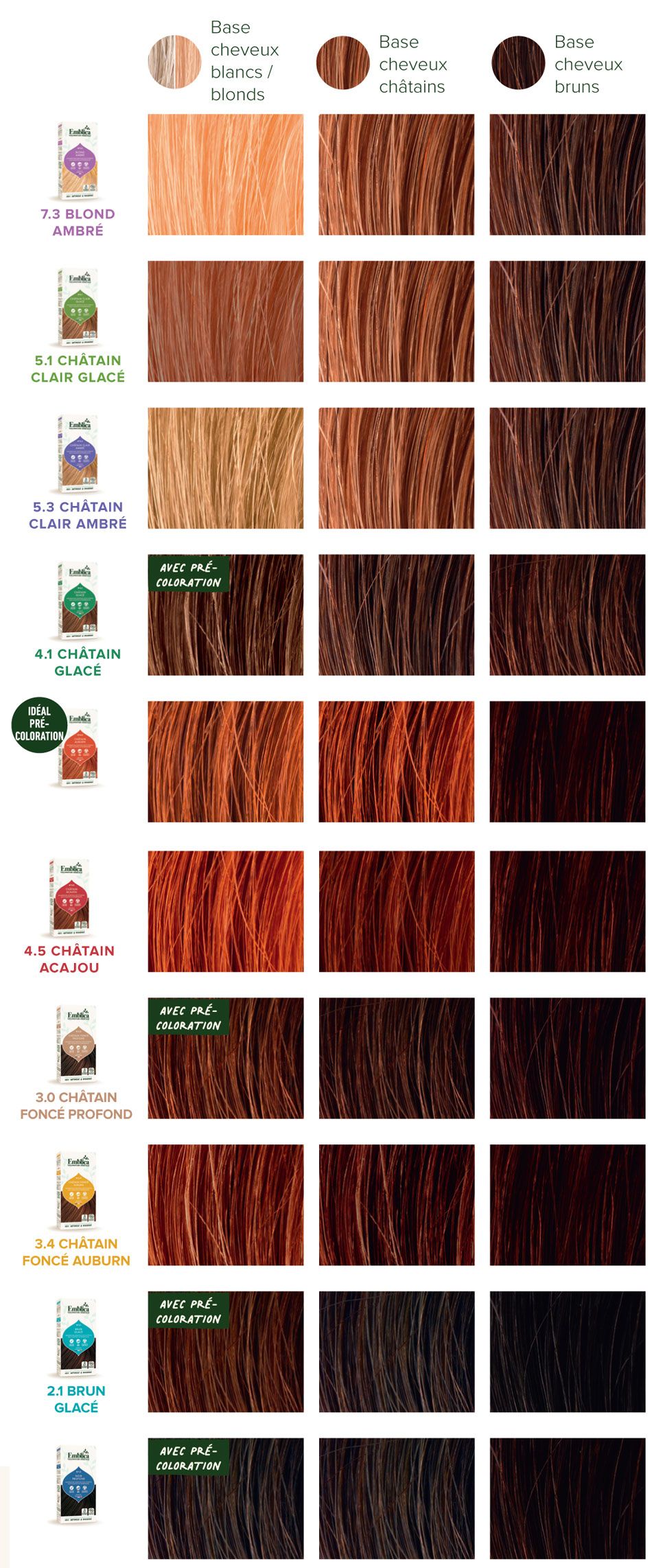







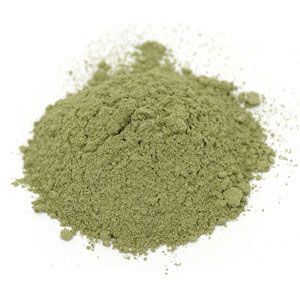

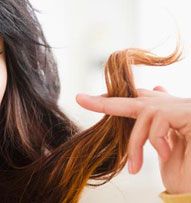
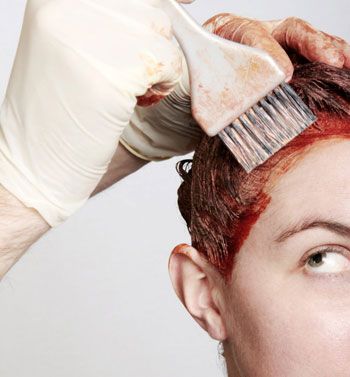
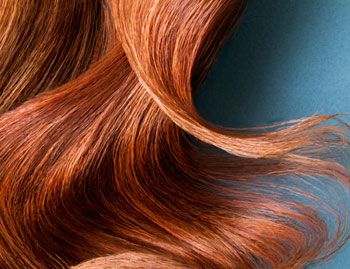
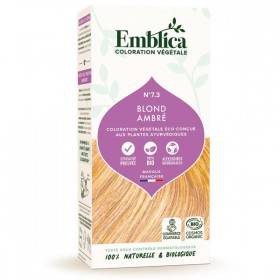
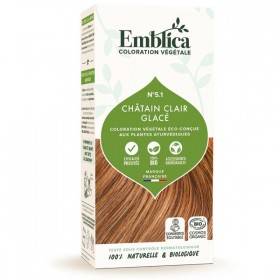
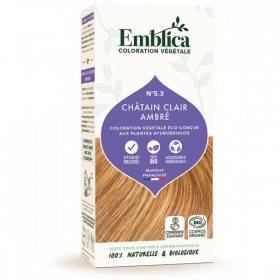
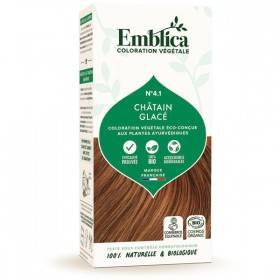
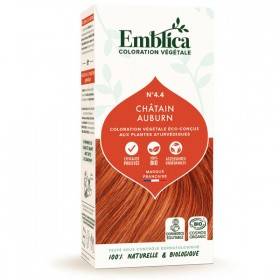
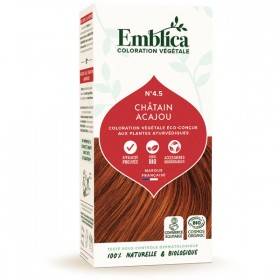
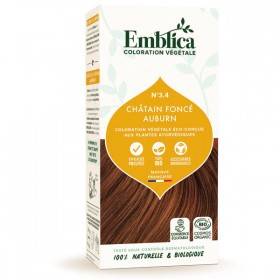
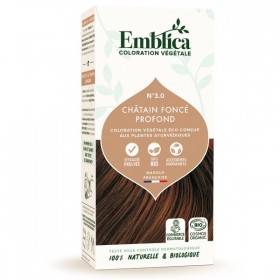
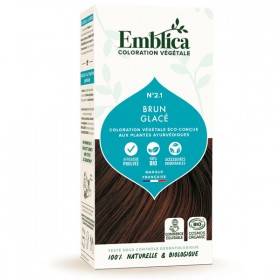
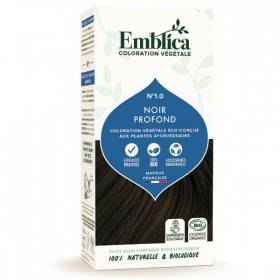
Customer reviews
très bien livraison dans les délais, colis intact, bon produit.
Martine
Félicitations pour la qualité de votre site & la valeur de ses informations ! Continuez ainsi ! On a besoin de vous !
Ronald
C’est la première fois que je commande sur ce site et pas déçue livraison rapide de ce produit que l’on ne trouve pas partout. Je recommande
Patrick
J'ai été très déçue de ne plus trouver mon déboucheur dans mon biocoop habituel, et perplexe en apprenant qu'il était remplacé par un produit à base de soude...c'est comme ça que je vous ai trouvé sur internet.<br /> Alors merci pour le dépannage, pour le mot gentil qui accompagnait mon colis , et bravo pour le calage en amidon de maïs compostable!<br /> Bravo pour votre démarche et à très bientôt.
Cécile D.
Correspond à mes attentes
Henry
Livraison rapide et bien emballé. Petit message manuscrit qui fait plaisir :)
xx
Envoie soigné et rapide.<br /> Merci pour le petit mot à la main.<br /> Très appréciable.
XX
Très satisfait de Penn'Ty Bio : choix étendu,prix raisonnables délais de livraison rapides.
xx
Comme d'habitude, envoi soigné, produits performants, Merci.
XX
Modèle conforme bien emballé délai respecter continuer comme ça parfait.
Carlos
Merci pour votre geste que j’apprécie.<br /> Cela fait plaisir de retrouver l’esprit commerçant de proximité chez un vendeur en ligne. Je surveillerai attentivement cette nouvelle livraison.
Philippe
J’ai bien reçu le nouveau diffuseur fonctionnel après essai et je vous remercie pour votre confiance et votre rapidité sur le traitement de mon problème. Ce n’est pas tous les jours que l’on voit un SAV aussi efficace !
Florent
Très bon produit, conforme à la description.
MICHELE P.
Bonjour. Je souhaite vous remercier pour votre rapidité. Le colis est arrivé en bon état . Les huiles que nous avons commandées embaument la maison. Ce diffuseur est génial.
Christian
Très bon site, très sérieux je recommande, produits de qualité et service après vente au top, de plus livraison des plus rapide et produits très bien emballés, tout est parfait
virginie
Un super magasin en ligne, avec plein de produits disponibles.<br /> L'envoi a été très rapide et soigné, avec une très bonne communication à chaque étape. Bref, une adresse à connaitre et à garder ! Merci !
Pab57
Merci. Je tenais à vous faire part de ma grande satisfaction. Je suis enchantée par les produits et par le service. Salutations et bonne continuation,
Odile
Livraison très rapide; Tout était parfaitement emballé. Je referai appel à vous.
JV39
Toujours très bien et parfaitement emballé ! Merci<br />
Valérie
L’esprit commerçant de proximité chez un vendeur en ligne !
Philippe
Livraison rapide et soignée. J'utilise les produits bio qui sont de très bonnes qualités. Un savon m'a été envoyée par erreur à la place de celui commandé et il m'a été remplacé très rapidement. Bravo pour leur réactivité. Je recommande fortement ce site.
Liliane
Livraison rapide. Produits bien emballés.
Bruno
Merci à Penn'Ty Bio pour la qualité des produits, la réactivité de l’Équipe et le petit mot attentif qui accompagne les colis. Votre site est précieux !!
Veronique B.
J'ai découvert ce site en cherchant de la terre de Diatomée. Livraison rapide. Très sérieux. J'ai mis la page dans mes favoris car j'ai repéré d'autres produits.
Isa
J'ai bien reçu mes articles et je vous remercie pour la livraison rapide et impeccable !
Françoise
Client depuis de nombreuses années, je suis satisfait à la fois de la boutique et de pratiquement tous les produits achetés.
Jean-Claude
Client depuis des années Produits de qualités et surtout qualité de service.
XX
Je voulais non pas faire une réclamation; mais vous féliciter pour vos produits que j' ai bien reçue, et également pour la rapidité de votre envoi ce qui est plutôt rare dans d'autre site.
Jérôme
Vos produits sont de bonnes qualités et les produits très bien emballés
Dominique
super contente, j'y trouve facilement les produits dont j'ai besoin et le service est impeccable et gentil !
Hélène S.
On ne peut pas toujours faire confiance à des sites de ventes sur le web, mais sur Penn'Tio, j' y viens les yeux fermés. Excellente communication avec le service clientèle, un suivi sérieux. Je remercie chaleureusement toute l' équipe.
Sergine T.
Tout était parfait l’envoi la livraison merci beaucoup
XX
Parfait ! Envoi rapide et produits de qualité. Merci pour le petit mot. Je suis très satisfaite !<br />
Julieanaïs
Dimanche soir, invasion de vrillettes du pain. Lundi matin, commande en urgence des produits verts adéquats. Mardi, livraison, traitement et fin de l'invasion.
Jean-Pierre
Très satisfaite par Penn ty bio. En effet, suite à un produit défectueux ( housse matelas) , j'ai aussitôt reçu un bon de retour pour renvoi gratuit en colissimo et ai reçu la nouvelle housse dans les 48 h, avant même le renvoi de la première housse. Merci pour la réactivité et la confiance de cette entreprise.
dominique B.
Produit de qualité conforme à mes attentes, envoi rapide et soigné, très bien.
Anne
Bonjour Sophie & QUENTIN, Merci pour votre petit mot. . . . Ça fait chaud au Cœur de voir qu'il y a encore des Gens Comme VOUS sur cette planète ! Le monde devient de plus en FOU ! ! ! Cordialement.
Dominique T.
C'est vraiment magnifique et ce cadeau a plu, je commanderais pour Noël.
Martine
MOI JE DIS INCROYABLE !!!<br /> Plus que mieux d'une rapidité de dingue ! bravo et le colis impeccable surprotégé.<br /> Que toutes les entreprises prennent exemple sur vous. merci
AURELIE A.
Bon choix, bons conseils et service livraison très rapide. J'aime faire mes courses sur ce site.
FDA
Envoi rapide, emballage au top, continuez comme ça... :-)
bruno b.
Envoi rapide et soigné, produits efficaces et réponse rapide à mes questions. Je recommande.
xx
Après un souci sur l’article livré, le site a fait preuve d’une excellente communication (simple et efficace par sms) qui m’a permis de me faire livrer un 2nd article par la marque très rapidement. Parfait !
Pierre
Site internet complet, beau et facile d'utilisation<br /> Commande complète et correcte.<br /> Commande emballée a la perfection avec du matériel recyclable, compostable<br /> Délai d'envoi respecté même a l'étranger (Pays-Bas)<br /> Mention spécial pour le petit mot personnalisé ++<br /> On sait pourquoi on commande chez Penntybio depuis 10ans :)<br /> Bonne continuation
Jennifer A.
Toujours satisfait et pour les prix et pour les produits.
andré a.
Je confirme efficacité sur la préparation et expédition du matériel. un grand merci
Jeremy
Produits facile à utiliser, efficaces et finalement pas plus onéreux, à l'usage que des produits issus de la pétrochimie. Service livraison impeccable. Je recommande +++<br />
XX
Efficace rapide et à l'écoute. Diversité des produits. Efficacité des produits. Respect des délais de livraison et prise en compte des spécificités client PMR ( ce n'est pas toujours le cas). Site bien fait pour navigation et produits bien mis en valeur. Des promos et des bons de réduction cumulés en fonction des achats. Merci pour votre efficacité rapidité et professionnalisme.
xxx
Les produits ont été très appréciés par la destinataire. <br /> De plus quand on pose une question, on a toujours une réponse, un conseil très rapidement. Merci pour votre réactivité
xxx
Bonjour, colis bien emballé arrivé sans encombre, démarche écolo bien ancrée et petit mot perso. Merci à l'équipe de Penn'Ty Bio.
Sofi
Tout va bien. Bonne année 2021.
Bernadette M.
Je tenais à vous remercier pour votre service de qualité, une livraison toujours rapide, des colis bien emballés - qui évitent fuites et casse, ainsi que pour le petit mot personnalisé joint à chaque commande, c'est toujours très agréable.
Isabelle G
Livraison conforme et rapide. Les produits sont emballés dans des emballages recyclables, voire compostables : j'ai beaucoup apprécié. Je recommande ce site.
Patrick
J'adore ce site qui fait un vrai travail de sélection de produits que je ne trouve pas ailleurs et sur une large gamme. Je recommande.
Veronique G.
Noëlle G.
Parfait comme site, commandes faciles à faire et livraison rapide !
Cindy
Bien, la majeure partie des produits sont efficaces. Je connais cette boutique depuis plusieurs années, je recommande ce site.
XX
Très bons produits je les recommande.<br /> Merci à Pennt'ty Bio pour tout, aussi bien pour les commandes et les emballages.<br /> Bravo Pennt'ty Bio.
Bernadette G.
Une utilisation de vos produits a suffit pour nous débarrasser des poissons d'argent. Merci.
Matthieu
merci pour votre professionnalisme. Merci pour les produits envoyés dans de bons délais. Merci pour la qualité de vos produits
Marcelle
Envoi rapide. Rien a redire.
Marie France
Site de produits naturels et bio très bien fait, agréable et fiable. beaucoup de produits de qualité.
Anne Marie R.
Site très pratique. Commande aisée. Suivi régulier. Délai de livraison respecté. Colis très soigné. Tout est parfait.
Nicole
Commande tout à fait conforme et emballée avec grand soin.
Sarah
Bons produits. Fonctionnent très bien.
xx
Très satisfaite. Je recommande cette société sérieuse. bon suivi de la commande.
Sandrine
J'ai bien reçu ma commande. Com' dab' , rapidité efficacité ...Merci
Sally
très bien je recommande.
Sylvie
Cliente depuis plusieurs années, j'apprécie toujours ce site. Meilleures salutations.
France
Très satisfaite du produit.Rapidité et emballage très soigné.SERIEUX.
MARLENE
Livraison très rapide. Notice livrée avec les produits ainsi qu un petit mot très agréable. Produits très efficaces, avec de l huile de coude, on en vient à bout. Le produit concentré nous a permis de tout éliminer. Par précaution, nous avons tout de même utiliser le spray. Dans une pièce, nous avons utilisé le fumigène. Pour les animaux, la mousse semble efficace. Dans quelques jours nous ferons le shampooing et plus tard les pipettes. Mais franchement après avoir utilisé d autres marques qui ne fonctionnaient pas, nous sommes ravies et nous recommandons ces produits. Merci
Virginie C.
Un diffuseur plus de 80 M², avec huile essentielles eucalyptus, vraiment formidable, on respire mieux et çà sent super bon. Le matin 1 heure, et le soir 2 heures. De jolies couleur, et pour les fêtes une jolie ambiance. Bravo.
PATRICK
Ravie de découvrir un site qui présente des produits de qualité avec une vraie démarche éco responsable à des tarifs intéressants.
XX
J’ai découvert cette société en faisant une recherche sur Internet pour trouver un insecticide contre les sclérodermes. Je ne peux pas encore juger l’efficacité de chacun des produits par contre je suis très satisfait de la rapidité et de la qualité d’expédition, ainsi que du sérieux de la société. J’ai même reçu un petit échantillon est un mot personnalisé j’ai trouvé ça très sympa! Merci beaucoup et bonne continuation pour votre société que je recommande déjà.
BJ79
Pennty Bio? Einfach genial. Super rapide , bon produits, super service-livraisons. Je vais recommander bientot =)
xxx
Je parlerais de vous a mes amies car vos produits sont vraiment excellents. Bien a vous et tous mes remerciements.
Patricia
Je suis vraiment très satisfaite de la prestation de ce fournisseur : délai de livraison très rapide et emballage des produits réalisé avec un maximum de soin. Bravo !!
Eliane
Merci et surtout, continuez, c'est rare de trouver sur internet une relation aussi personnalisée sur un mode aussi agréable.
Sabine
Livraison très rapide et colis emballé soigneusement.Site à recommander.
isabelle d.
Nous sommes très satisfaits du service client : mot personnalisé dans le colis, disponibilité du service après-vente... Nous souhaitons à votre société un succès croissant.
Sara
super emballage écolo...bravo !
Isa
De très bons conseils, une livraison rapide et des produits de qualité !
Fabienne P.
Un grand merci pour la qualité et la rapidité de votre réponse.
Tony
Je trouve l'essentiel sur le site à des prix défiants toute concurrence. Continuez comme cela.
XX
Je me permets de vous écrire un petit mot afin de vous dire que votre site est très bien fait.
Tom
Un plaisir de recevoir les colis soignés et respectueux de la planète de Penn’Ty Bio. Merci
k.
livraison tip top tant en temps et en qualité.
XX
Merci beaucoup pour la rapidité avec laquelle vous m'avez fait parvenir le diffuseur.
Bichette
Bon rapport qualité-prix. Envoi rapide et sécurisé !
Chrile
Je viens de recevoir la pastille noire aujourd'hui et je vous remercie de votre envoi gratuit (ce qui est rare de nos jours).
Laurence
Produits de bonne qualité, naturels et efficaces, expédition rapide et bien emballée, sav très rapide suite à une erreur de ma part,
XX
Content des produits achetés, reçu rapidement et bien emballé. Merci.
XX
Les produits achetés sur le site sont de très bonnes qualités, et j'ai été très bien conseillée. Je recommande !
Aurore
Excellents produits. Excellent service.
James T
Livraison ultra rapide, bien emballée. Produits au top. Parfait !
Caty
Je ne connais pas encore tous les produits mais contente de ce que j'ai commandé. En revanche un peu cher quandmême ce qui me limite.
xxx
Un accueil téléphonique très agréable et de très bons conseils. <br /> Merci à vous.
XX
Bravo ! je vous félicite pour votre efficacité ne manquerai pas de vous conseiller. Merci à la prochaine commande
Anthony
j'ai reçu mon colis aujourd'hui, merci c'est très rapide et sérieux.
Clara
J'ai enfin reçu le petit colis, hier. Il a mis un mois pour me parvenir, mais vous n'y êtes absolument pour rien, comme je le pensais, il a été mis de côté lors de la grève nationale. Je vous remercie d'avoir fait faire des recherches, j'ai reçu un mot de la poste.
Hervé
Merci à Penn'ty bio d'avoir garder beaucoup de produits de la marque Lerutan et pour le sérieux dans la préparation et l'expédition des colis. Je recommande.
SR
Une entreprise fiable, efficace, de confiance, chez qui je recommande de faire ses achats.
S.
Super produits accueil plus que parfait gentillesse. Livraison au top merci beaucoup
Christiane
Au fil de mes commandes (j'en suis à la 5 ou 6ème) décidément, du sérieux et de l'écoute ! chaque fois que j'ai eu un petit problème: contact immédiat, réponse immédiate, et tir rectifié illico ! Dans le top 5 de mes sites internet !
Vincent
Excellent!! Commande passée le lundi, reçue le mercredi!!! Les produits sont en plus de super qualité !
MADELINE
Pennty bio prends le temps de renseigner et donne de très bons conseils.<br /> Les produits sont emballés soigneusement et la préparation des commandes hyper réactive. Je recommande les yeux fermés !
Mattloumag
Françoise
Une grande compétence, Monsieur Dufil est très professionnel et sait soigner ses clients. Quand à la gamme de produits proposés, elle est parfaite et complète.
Alain A.
Tout à fait satisfait de la qualité de la livraison ainsi que du produit commandé.
Régis
produit parfait.
René
Pas encore essayé le produit, mais le site est très sérieux. Livraison dans un temps éclair, même si je suis en Belgique. Emballage soigné. On peut faire confiance.
Roberta
Super produits, envoi rapide et soigné, conseils et échanges courtois ! Une jolie boutique en ligne pour acheter en toute confiance ! <br />
Patricia
Commande bien reçue;je suis tout à fait satisfaite;à bientôt
Sonia
Je vous remercie de votre professionnalisme et de votre réactivité.C'est loin d'être toujours le cas lorsque l'on commande sur internet.
Gaëlle
Livraison rapide, emballage plus que parfait, le diffuseur NEOLIA est merveilleux pas bruyant, fonctionnement idéal. Merci PENNTYBIO pour votre sérieux, site web à recommander.
CLAUDE
Très contente d'avoir découvert ce site internet ! Du conseil jusqu'à l'achat c'est super. J'étais très embêtée après l'apparition de petit insecte chez nous (des anthrenes) et c'est le seule site internet e-boutique qui a pu nous renseigner dessus et enfin indiquer les produits pour les éradiquer sans pour autant nuire à notre santé (mais en respectant les conseils d'utilisation bien sûr). J'ai reçu ma commande rapidement, et avec surprise un petit mot de remerciement personnalisé avec mon nom dessus. Des détails qui au finale font la différence. Un service de qualité rien à dire. Merci !
XX
Très contente des produits de qualités et une commande reçu très rapidement. Merci
PATRICIA A.
Site de grande qualité !
Rose Anne Marie
La livraison est rapide, je n'ai jamais était déçue de ce site, et les produits sont pas chers et de très bonne qualité!
Patricia
Livraison rapide , produits de qualité, je recommande Penn'Ty Bio.
XX
Bons produits conformes à mes attentes et livraison au top. Je recommande vivement.
Chantal P.
Livraison rapide et très bien emballé et protégé. Très bonne efficacité. <br /> <br />
XX
Tout est parfait à chaque fois. L'attention portée va même jusqu'au petit message, c'est agréable. Fidèle aux produits et au site plus que jamais.
xx
Très bon site, du personnel sérieux et la livraison en temps et en heure. Merci
Marine T
Livraison rapide et petit mot manuscrit joint au colis, vraiment très sympa! Merci et continuez, vous le méritez.
Jean-Pierre
JM
Bon produit. Merci Penn'Ty Bio. Un seul passage dilué à 5% et les puces ont disparus. Il en restait deux ou trois qui ont dû se perchés pendant le traitement mais sinon c'est performant.
Axel
Un grand merci pour votre offre et votre professionnalisme. Pour un service en ligne, vous savez vous rendre proche de nous. Bravo et "suerte" !
Pierre M.
Toujours impeccable, les produits, les services. Depuis que j'ai changé de facteur, plus de soucis. (Ça n'est arrivé qu'une fois!!!)
XX
Livraison très rapide. Bravo pour la réactivité
François
Colis bien arrivé. Emballage remarquable. Diffuseur très joli, très efficace et peu bruyant avec de la couleur qui change. Très satisfaite de la commande.
Sabrina
Parfait. Rien à redire. Extrêmement efficace.
Quentin
Site intéressant. Je l'ai découvert, en fait. Produits ménager éco-responsable. Bon pour la maison et non agressifs. Merci.
Mydiadao
Rapidité, emballage nickel et écologique, mot de remerciements personnalisé, produits au top....j adore....je suis une nouvelle cliente conquise. Un grand merci...
Hélène P.
Parfait !
Mireille
Livraison rapide et fiable, dès que le chèque a été reçu. Produits de bonne qualité.
Chantal H.
SATISFAITE
ANNE
Personne disponible, de très bon conseil suite à des punaises de lits dans mon habitation, les produits sont efficaces car depuis aucune punaises et la vie à repris son cours ... merci pour tout
Nathalie
Très bon produit juste ce qu'il faut à prix attractifs Envoi rapide.
xx
Livré hyper vite. Bravo !
Mick
Commande passée le jeudi soir, colis livré chez mon "commerçant-relais" le samedi matin. Quelle rapidité ! Du vrai professionnalisme !
Emeline
Commande reçu en 2 jours, impeccable. Tous les produits emballés avec le plus grand soin, petit mot personnalisé! Et encore un petit savon bio au parfum délicieux comme cadeau!! Merci Penn'Ty Bio !!
Orchidée
Les produits achetés sont excellents. Ils répondent parfaitement à ce que je cherchais. Bravo pour votre site
Michel
Bravo ! je vous félicite pour votre efficacité et ne manquerai pas de vous conseiller.
Nicolas
Très bien ! envoi rapide et conforme à ce qui est annoncé.
Jacqueline S.
Site sérieux, proposant de bons produits, efficaces en particulier sur les punaises de lit, fléau actuel. Merci car entre les produits et les housses de matelas nous avons réussi à les éradiquer dans deux maisons à deux ans d intervalle. <br /> Bravo aussi pour la livraison la plus écologique possible.
L.C
merci de votre disponibilité et amabilité!
Eric
J'ai été TRES bien conseillée lors du contact. Produit naturel donc c'est parfait.
Lilla
Très bien...merci.
Olivier
J'ai toujours été satisfaite de mes commandes chez Penn'ty bio. Rapide efficace. Surtout les caractéristiques des produits est claire et complète. et le site contient beaucoup d'informations sur les différentes gammes. Merci pour votre travail et votre activité.
XX
Rapide, sérieux, très bien emballé, un sans faute.Merci.
L.H.
accueil téléphonique personnalisé réactif compétent et bienveillant, livraison rapide et conforme. BRAVO merci pour la qualité de votre travail
Annick
fiable et de bonne qualité pour les services et les produits :)
XX
C'est extrêmement délicat de votre part d'avoir fait diligence. Je ne manquerai pas de recommander votre site et de souligner votre gentillesse. Encore merci
Michel
Excellente communication, service très rapide (même à l'étranger), emballage parfait ...
Jacques N., Belgique
Claudine
Super efficace !!!
xx
Super, envoi rapide,bien protégé et petit cadeau !
xx
J'ai bien reçu le diffuseur et j'en suis très content.
Paul
Commande bien reçue ! Bien emballée ! ! ! Jolis produits ! Merci !
AYH
Je suis ravi de trouver les produits de qualité et d ‘efficacité incomparable.
Denitza K.
Service clientèle très réactif en cas de difficultés. Livraison rapide. Emballage des produits fragiles excellent. Maison sérieuse, je recommande.
Marie
Excellent article sur les diffuseurs d'huile essentielles ! grâce à lui j'ai pu faire mon choix basé sur une excellente analyse de votre part !
Laurence
Bon produit , envoi rapide.<br /> <br /> <br />
Christine
trés satisfaite de ma commande,( produit, et livraison,rapide ) MERCI
Danièle M.
Tout est parfait : la qualité des produits, la rapidité d'expédition, la qualité du colis. Je suis enchantée et resterai fidèle à ce site.
Dominique
Parfait comme d'habitude
Sylvain
Excellents services, très serviable
XX
Bonjour Monsieur,<br /> Nous nous étions parlés au téléphone il y a quelques années. Bravo pour l'évolution de votre site et vos dossiers instructifs. Vos produits aussi sont très bons. Bonne continuation, bien cordialement.
Marina
Marie Aline Roux
Bravo et merci : produits de qualité et service TOP... continuez !...
XX
Marie-Noëlle
Produit performant et raisonnable au niveau prix. Je recommande
XX
Alex
Efficace, livraison rapide.<br /> <br />
H
Après 2 traitements à 3 jours d'intervalle, j'ai réussi à éradiquer toutes les punaises de mon canapé. Produit hyper efficace que je recommande vivement.
Emmanuelle
Je vous remercie beaucoup de m’avoir fait profiter d’un acheminement par Colissimo alors que rien ne vous y obligeait, sauf votre conscience professionnelle, chose rare de nos jours et qu’il ne faut jamais manquer de souligner.
Cécile
BIEN,CONTINUEZ COMME çà.
XX
Toujours aussi "réactif" et efficace<br /> Bravo et merci pour votre professionnalisme.
Annick P.
Tout est parfait de la commande à la réception. Commander jeudi et reçu samedi. Et très contente de mon achat . Je recommande
Nadege M.
Service de qualité, suivi rigoureux, et rapidité au rendez-vous. Les produits sont très fidèles à leur description et pour un coût serré. A recommander fortement.
JACKY
Cliente depuis plusieurs années. Super service, réactif, cordial. Les produits sont excellents.
Christine
Excellent site rapide et efficace. Descriptif intéressant.
XX
C'est ma première commande chez Penn'Ty Bio, et ce ne sera pas la dernière.<br /> J'étais à la recherche d'un nouveau diffuseur d'HE et, après discussion avec Quentin, mon choix s'est arrêté sur l'Elixia (Direct Nature) qui est d'une efficacité redoutable et d'un silence absolument surprenant.<br /> La livraison s'est faite en 72h en point retrait avec un conditionnement hyper sécurisé.<br /> Lors du déballage, j'ai constaté un léger défaut de finition sur la verrerie.<br /> J'en ai fait part à Quentin par texto avec photos à l'appui.<br /> Il m'a aussitôt recontacté pour me proposer un envoi d'une nouvelle verrerie dès que disponible.<br /> Un professionnalisme et un sens du service exemplaires qui font de cette enseigne une valeur sûre.<br /> Penn'Ty Bio est vraiment la boutique en ligne qu'il vous faut connaître.<br /> Je vous la recommande vivement.
Jean-Yves S.
En cette période d'avant Noël, je craignais que me colis arriverais en retard. 48h après mon achat, c'était dans la boîte aux lettres. Du coup, je suis large pour mettre mon achat sous le sapin. Merci à vous
Art4
Site très sérieux et personnel vraiment agréable. Envoi rapide. C est parfait !
Ingrid
Très bon produit facile en entretenir, pas cher.
XX
Les produits commandés sont conformes à mes attentes. Quant à l'accueil au téléphone, il est parfait et nous avons toujours trouvé un terrain d'entente. Je fais confiance à Penntybio.<br /> Merci.
XX
Livraison très rapide et produits bien emballés.
Catherine
Jean-Yves
livraison impeccable, produit bien emballé et correspondant au descriptif, excepté pour la surface de diffusion, ma salle principale doit faire 25m2 maximum et ça ne se diffuse pas au-delà.
Pascale
Envoi très rapide et bravo pour votre site de reconnaissance des insectes nuisibles.
Brice
Très satisfait du site livraison rapide.<br />
Michel
livraison rapide, produit conforme.Prix séduisant.
XX
j'ai bien reçu la commande et je vous remercie pour votre efficacité.
Margot
Hélène
Je suis arrivée sur votre site en cherchant un diffuseur que je viens de commander, mais je voudrais vous dire que votre site est très intéressant, bien fait. Vos dossiers sont enrichissants merci
Joelle
2 commandes à mon actif et jamais déçue. Vous avez gagné une cliente régulière :) Merci pour votre sérieux et le contenu bien rempli de votre site ! c'est super d'avoir une description hyper détaillée de chaque produit.
Magali
Excellent service après vente après un problème d acheminement de colis par la Poste. Une relation client de très grande qualité. <br /> Cordialement,<br /> <br />
PV
Client depuis plus de 10ans. Toujours satisfait du matériel propose. Boutique sérieuse prix compétitifs livraisons et suivis rapide.
XX
Mon avis sur penntybio, très bon produit sur ce site pas une gamme monstrueuse mais que du très bon, et pareil pour les livraisons ultra rapides et le excellent sav si besoin. Je recommande vivement. Client depuis 2018 aucun soucis.<br /> <br />
thierry g.
Rapide, sérieux et qualité, produit correspondant à la description, très contente, je recommande votre site et vos produits.
Corinne
J'adore. Très grande diversité de produits, les explications sont simples et complètes.Quand aux colis, ils sont extrèmement bien protéger. Un grand merci.
Nadine
Pour ma part j'ai été satisfaite de la réalisation de ma commande et du délai de livraison. Je recommande votre société.
Nelly
Produits utilisés depuis très longtemps, toujours la même qualité ! Je recommande, les délais de livraison sont très courts, produits très efficaces.
Laurence
Sophie. A
Site sérieux. Bons produits.
Magali
Avec les trois lettres BIO dans votre nom, je ne m'attendais pas à découvrir des billes de polystyrène comme matériaux de rembourrage. Il y a certainement plus écolo !
Michel D.
Très bon site. Navigation facile. Les commandes sont expédiées rapidement comme annoncé. Aucun problème depuis que je suis cliente. Je recommande Penn'ty bio.<br />
Elvyne
Impeccable.
Christine
Livraison rapide et produit conforme à la description. J'approuve à 100% le principe du recyclage des éléments d'expédition. Un produit fabriqué une fois soit avoir plusieurs vie. Bravo pour cette initiative.
Christophe
Parfait.
Philippe
Merci pour tout le soin que vous mettez pour une livraison individualisée, chaleureuse et aussi peu impactante que possible sur l'environnement !
Sandra
Vos explications par email ont été très claires et votre diligence dans le traitement de ma commande et de mes demandes est très appréciée.
Henri
Produit anti puce extrêmement efficace !<br /> Le vendeur a pris une demi-heure de son temps pour m'expliquer absolument tout ce qu'il y avait à savoir sur le produit, de la composition a la mise en œuvre.. Bref au top ! Je recommande donc vivement Penn'ty !
Louis
Envoi rapide et soigné. Emballage ecoresponsable. Je suis ravi d’avoir trouvé des pièces de rechange pour les diffuseurs à huiles essentielles!
Ina L.
Toujours parfait, livraison, emballage, délai et gentil petit mot personnel pour me remercier de ma fidélité.
XX
Commande reçue rapidement, très bien
XX
Excellent site d'achat. Très rapide et que de bons produits.
James
excellent.
XX
Commande facile, livraison impeccable et produits fiables. Merci.
Isabelle
J'ai bien reçu le colis sans aucun problème. Merci pour la rapidité et le sens du service.
Nicolas
en comparaison d'autres produits employés précédemment, je trouve les vôtres beaucoup plus efficaces et cela sur le court terme ,disparitions des odeurs en combinant les produits suivant vos conseils .
XX
Un grand merci pour votre professionnalisme et la qualité de vos produits. Longue vie à votre site.
XX
Boutique très sérieuse avec un envoie rapide et des produits super efficaces.
XX
rien a redire, sauf, le montant des frais de livraison, un peu élevé.
XX
Bonjour <br /> C'était ma première commande sur votre site et j'en suis très satisfaite <br /> Je vous remercie pour votre professionnalisme (site, prise de commande, livraison) ainsi que pour le petit mot qui rend le tout humain. Très belle journée.
CG
Merci pour cette première commande, envoyée très rapidement, et dans un petit colis, avec frais de port très raisonnables.
Valérie O.
Jean Claude
Après la découverte des punaises de lit dans 2 chambres de notre vieille maison, j'ai trouvé votre site. le dossier m'a été très utile et je suis très contente d'avoir trouvé des produits moins toxiques que ce que proposent les autres sites de vente.<br /> Je vous remercie d'avoir répondu à mon mail car c'est un peu l'affolement quand on découvre chez soi des punaises de lit.
Françoise S.
Très bons produits efficaces.
XX
Produit conforme aux attentes.<br /> <br /> <br /> <br />
Alain
Site très réactif livraison rapide le produit Stop tique et puce est parfait sauf le pulvérisateur.
Danielle B.
Commande reçu très correcte, très bon matos, encore merci et bonne continuation.
Dominique et Monique A.
Merci pour votre envoi : rapidité, ponctualité, information de suivi du colis etc. Vraiment du bon boulot.
E.G
Jamais déçue : les produits correspondent à la description et sont livrés rapidement.
Mireille
Je vous remercie pour vos services. C'est très agréable d'être informé de la sorte.
Anthony
Très bien , bon produits, La prochaine commande avec plaisir, livraison très rapide.<br />
Rainer
Juste ce petit mail pour vous dire que j'ai bien reçu votre colis et que mon patron est enchanté ! Ca embaume les huiles essentielles dans le bureau et... ça ne fait pas de bruit ! Encore un grand merci pour votre gentillesse et votre souplesse commerciale.
Sonia
Livraison express. Colis toujours aussi bien préparé (cales, flocons, adhésif sur les bouchons qui risquent de couler). Bravo pour votre professionnalisme.
Isabelle
Rapidité de traitement et petit mot avec le colis très appréciable.
XX
Prix intéressants. Expédition super rapide à bon prix. Et tout ça de façon agréable !
Alexis M.
Penn'Ty Bio wonderfully served our family in Switzerland so that we could try the range of Totemsavon products, which are such caring, loving, and consciously manifested creations :)<br /> <br /> By allowing a shipment to Switzerland and elsewhere, I am sure so many more people would be able to benefit from the beautifully selected product portfolio in Penn'Ty Bio and all, together, make a conscious leap by using and demanding a way more purer approach to anything we interact with.<br /> <br /> Thank you so so much Penn'Ty Bio!<br /> <br /> In 8 Love We Heart Trust<br /> <br /> Miguel Ángel
Miguel Ángel
Rapidité de livraison. Très bon produits. Merci
Mélina
ANNE
Livraison rapide et avec colis préparé avec soin :)
Florian
Livraison rapide , le tout correspond à mes attentes.
Julie
Produits livrés rapidement dans un colis non surdimensionné, les produits sont conformes à la description. Je recommande vivement ce site très bien fait !
Hervé
Boutique sérieuse. Commande arrivée très rapidement. Merci pour votre gentil mot avec la facture.<br /> <br /> <br />
I Defoy
j'ai reçu mon colis aujourd'hui, merci c'est très rapide et sérieux.
Nathalie
J'ai reçu le colis, merci beaucoup de votre promptitude et bonne continuation.
Louise
Cliente fidèle depuis plusieurs années, je ne peut que recommander ce site. Tout est parfait. Tous les produits au top, rapidité d’envoi, gentillesse, allez y les yeux fermés vous ne serez jamais déçus.
Marité 06
Satisfaction totale. Entreprise au top. J'ai téléphoné le lundi matin, malgré que les contacts téléphonique ne sont que l'après midi, une personne très charmante m'a rappelé presque aussitôt pour mes donner les infos que je souhaitais connaître sur ma commande. Bravo. nous sommes mercredi et ma commande est arrivée. Encore bravo continuez comme ça.
Jacques M.
colis dans les temps,emballage parfait,super accueil téléphonique pour renseignement, je recommande ce site.
ROSCO
Excellente réactivité !!! Produit en stock, commandé le 23 dec à 8h30, recu le 24 dec à 9h30. On peut guère mieux faire ! Super communication avec le vendeur.
Xavier
yvette
Fiable, et très bons produits , Service après vente efficace et sympathique.
Vilma V.
Très bons produits, service rapide et de qualité, rapport qualité/prix intéressant. Je recommande vivement.
Alain
Service très réactif, emballage soigné , livraison rapide. <br /> Rien à redire . Continuez !!
Sophie
Franchement, Penn'ty bio, c'est top ♥<br /> Quentin est super réactif, de très bons conseils. Encore merci de votre efficacité.
Hélios ☼♥
Dommage, les vendeurs ne savent pas lire les indications inscrites sur les produits qu'ils vendent
XX
Service rapide et efficace. Bons produits
XX
1ère commande. Très satisfaite : Colis expédié très rapidement et bien emballé. Merci pour votre sérieux.
Ghyslaine
Sav rapide et disponible. Au top
Severine
fidèle cliente de Penn'Ty Bio, je ne me fournis que chez eux.
XX
Envoi très rapide, personnalisé et soigné. Merci
XX
Site intéressant proposant de bons produits, attractifs et respectant la nature. Le regret c'est le prix de certains articles.<br />
Catherine
Merci pour le geste commercial, et aussi pour les nombreux conseils et l'excellent service client.
Tristan L
Merci beaucoup le colis est arrivé à la poste hier et je te retire aujourd'hui Merci pour votre efficacité et votre rapidité
Ingrid
Cela fait plusieurs fois que je commande chez Penn'Ty Bio et je suis toujours satisfaite de la qualité des produits et de la rapidité d'expédition. Je recommande ce site !
Ghyslaine
THIERRY
Excellentes prestations. Les produits sont formidables, l'emballage aussi. Les délais d'expédition compétitifs. Je recommande vivement Penn'Ty Bio à tous ceux que l'état de la Planète pour les générations futures inquiètent.
XX
C'est la deuxième fois que je commande sur ce site. J'ai découvert qu'il existait des verreries aux dimensions différentes. Mon diffuseur étant ancien, j'ai chercher le modèle le plus adapté et j'ai trouvé! Mon diffuseur fonctionne à nouveau
Christiane D.
Super !
Yann
Ma commande s'est déroulée sans aucun problème avec une livraison rapide et soignée. La satisfaction est au rendez-vs ! Continuez ainsi ! Merci et cordialement !
Etoile 07
Livraison très rapide et produits intacts à l'arrivée grâce à un emballage impeccable.
Etta
Un grand merci pour cette commande envoyée très rapidement. Je recommanderais votre site
Elise
anne-marie B.
Service au top !!!<br /> Colis reçu très rapidement avec un petit mot manuscrit me remerciant de ma commande et de la confiance que je leur ai témoigné <br /> Suffisamment rare pour être signalé <br /> Je vous encourage toutes et tous à les soutenir en passant commande chez eux!!!!<br /> Longue vie à Penn’Ty Bio !!!!<br /> Ils le méritent
Pierre-Steph
très satisfaite de ma commande site vraiment sérieux livraison soignée et rapide ,les articles sont conformes a la description,je suis enchantée et recommande vivement
Marie Viviane C.
sérieux
XX
Tout était parfait. Produit, prix, délai.
Marco
2 commandes à mon actif et jamais déçue. Vous avez gagné une cliente régulière :) Merci pour votre sérieux et le contenu bien rempli de votre site ! c'est super d'avoir une description hyper détaillée de chaque produit.
clara
Merci beaucoup pour votre rapidité et votre professionnalisme.
Julie
Merci pour votre sérieux et la réexpédition ultra rapide d'un achat non conforme (dont vous n'étiez pas responsable).
Marc
Très réactifs entre la commande et la livraison. Je suis toujours satisfaite de mes commandes soigneusement emballées !
France L B
Merci d'être à l'écoute pour notre terre et vos clients. Encore une fois je suis très satisfaite de ma commande. Et mes compagnons à 4 pattes sont ravis de se protéger en bio. Merci pour votre attention manuscrite en fin du bon de commande..
Raymonde julie L.
livraison rapide, produits bien enveloppés avec juste un petit bémol : pour l'imperméabilisant dont le couvercle n'était pas bien fermé.
Alain
Commande bien reçue . Je suis très satisfaite Merci pour votre sérieux
LILIANE
Merci beaucoup pour l'info, c'est rapide chez vous, très appréciable!
Denis
Grande gentillesse et efficacité : que demander de plus ? Merci !
Chantal M.
Bien reçu. Bravo pour votre extrême rapidité. Merci
Magali
I had a marvelous experience with ordering and everything ! Thank you for a great service.
XX
Hyper cher :: très déçue du prix par rapport à la quantité de produit acheté. Sur le site internet, les flacons semblent grands, or pour 80 euros je me retrouve avec 4 flacons de petits produits insecticides... trop cher
xxx
Livraison en temps record à l'adresse indiquée en France puis départ dans l'océan indien. Reception des produits en quinze jours à l'autre bout du monde : ravie. Je vous laisserai les avis produits une fois utilisés. Le site est très bien fait et très agréable à utiliser. Le petit mot à la main dans le colis humanise la transaction, je l'ai apprécié. Je pense que vos produits sont très utiles et je vous souhaite une belle réussite et sur la durée.
Sylvie D.
Des produits très efficaces quand on suis dans l'ordre le traitement. Un léger petit bémol sur le spray insecticide, si possible essayer de trouver un spray plus puissant et plus large pour une diffusion optimale dans les coin et recoin inaccessible. Sinon tout est nickel est une excellente qualité de résultat.<br /> PS: Il faut prendre tout les produit pour un traitement efficace en foyer privé (maison).
Florian G.
Emballage au top. Livraison rapide et sans dégâts.
xxx
Bonjour Sophie et Quentin,<br /> Je viens de recevoir ma commande et je tenais à vous remercier pour la rapidité de l'envoi, votre gentil petit mot et le petit présent qui sent bon et donne envie. Bel été à vous deux également
Geneviève
je vous remercie pour vos services, c'est très agréable d'être informé de la sorte. colis bien reçu Merci pour la rapidité de la livraison
Bernard
Bon service et bon produits
Odile R
Everything was very nice ! Keep handling your customers likes this!
xxx
Sav très réactif et efficace suite à avarie durant transport. La livraison du produit en remplacement du colis défectueux à été particulièrement rapide. Merci.
Valérie
Efficacité redoutable. enchanté.
Robert
Merci et bravo pour la qualité des produits et du service toujours aussi efficace et performant.
Annick P.
Super, livraison rapide, suivi très rigoureux, site de confiance, très sérieux à recommander... Merci pour tout.
Bernard
Très bon site avec de très bons produits et un soin particulier apporté à la préparation de chaque commande... De plus, Sophie et Quentin prennent la peine d'écrire un petit mot de remerciement avec la commande envoyée....c'est peu commun mais très sympa....:-)
STEPHANE P.
Très rapide pour la livraison en Belgique et sérieux. Merci<br />
Corinne
Site pratique, compétent, prix corrects. Un envoi très rapide, et je dirai "parfait".
Greg
Bon produit mais frais de port un peu cher.
Marie Paule
Maryse
J'apprécie les services de Penn'ty bio. Un maximum d'étoiles pour eux.
Ch. D.
Colis très bien protégé service rapide. Merci. Site très sérieux .
Elios R.
Site très sérieux, de très bons produits et la livraison est rapide.<br />
Isabelle
Merci à tanteOdile pour m’avoir fait découvrir votre site. Depuis je suis une cliente assidue. Très satisfaite de la rapidité des envois, de la qualité de vos produits qui sont par ailleurs très bien détaillés par leur composition et leur mode d’emploi. Une amie vous a rejointe également avec la même satisfaction <br /> Continuez.
Marité D.
Très satisfaite des délais, les produits sont bien emballés et le petit mot sympathique est fort agréable!<br />
Sylvana
Commande bien reçue. Je suis tout à fait satisfaite. A bientôt.
Tania
Parfait! Préparation et expédition de la commande hyper rapides. Emballage très soigné (j'ai acheté un produit fragile). <br /> Je suis très satisfaite!
Elise M.
Bravo pour votre sérieux. Colis reçu très vite et produits impeccables. Belles fêtes de fin d'année
Mat
Je voulais vous remercier +++ pour votre gentillesse et surtout... votre compétence. C'est vraiment de l'excellent travail... j'ai été bluffée :-)<br /> Renseignement téléphonique 10/5 - produit 10/5... encore merci
Maryse
Un grand merci pour la qualité et la rapidité de votre réponse.
Simon
Je suis très satisfaite de mon échange avec le service client (personne à l'écoute, de bon conseil). Envoi rapide et soigné, avec un petit mot sympathique de l'équipe, le top!
XX
MERCI au personnel à l’emballage !!! Ma dernière commande était super bien emballée. Elle a résisté aux (épouvantables) chocs subis pendant le transport. Merci
Veronique
Je suis cliente depuis de nombreuses années. Toujours satisfaite du site, des produits et de la livraison.
martine O.
colis reçu ce jour, merci pour le flacon offert
Andrée
Les produits sont de bonne qualité. Leur prix est raisonnable. Ils sont livrés rapidement, et en bon état.
XX
clair net précis. merci
jannick
Très bien !
XX
Parfaitement parfait, je ne me fournis que chez Penn'ty bio depuis qu'ils m'ont débarrassée de punaises de lit.<br />
MARIE CLAUDE G.
J'apprécie depuis de nombreuses années la qualité de vos produits et le sérieux de votre site. Une petite mésaventure avec un diffuseur me permet de vous féliciter pour la réactivité de votre SAV. Bravo !
Thierry G.
Explication, commentaire et livraison en un temps record, tout était parfait, même le petit mot de remerciement écrit à la main ! Merci beaucoup
Monique S.
Juste un petit mot pour vous remercier de votre disponibilité et pour vous dire également que je suis très satisfaite des produits que j'ai acheté, ils sont vraiment efficaces.
Barb.
livraison rapide ,prix raisonnable , produits super efficace j'ai vite calmé mes douleurs lombaires ...enfin soulagée . Merci pennty bio
JEANNINE
J’ai bien reçu mon colis et vous remercie de votre rapidité. Bravo pour le geste écologique et durable. Emballage nickel ! Et mon chat a adoré jouer avec les billes jaunes !
Anouk
Fidèle à votre marque, je tenais par ce mail à vous féliciter vous et votre équipe pour votre longévité. Votre marque est toujours gage de qualité et sérieux.
Céline
Diffuseurs qui sortent vraiment de l'ordinaire, un envoi parfait - merci BCP
Anthony
Très bien, je recommande cette boutique
Salomé
Bon produits et service !
Rose-Marie
Bonjour, je voulais vous féliciter pour la clarté de votre site, la rapidité de la livraison et la qualité de l'emballage.
catherine R.
Après essais de divers produits, votre insecticide 4J est le seul à être venu à bout des puces ramenées par le chat de la maison. Livraison rapide par chronopost
JEAN MARIE
Bon produit, efficace et laisse une odeur plutôt agréable. Expédition rapide, emballé avec soins. Je recommande
Mary
J'ai reçu mon colis hier. Merci de vos démarches,
Sam
Produits performants. Très satisfaite de vos services.
XX
J'ai bien reçu ce jour, en bon état, les 2 diffuseurs galets. Merci aussi pour votre petit mot manuscrit me souhaitant un bel été. Fidèlement,
Annie
Produits conformes aux descriptifs. Délai de livraison respecté. Satisfaite du nébuliseur qui est superbe.
VR
Merci pour votre efficacité et votre gentillesse, commande, livraison, petit mot agréable, tout était parfait !
Sylvie
Commande reçue assez rapidement. Merci pour votre sérieux.
Émilie
Penn' Ty Bio, c'est ma référence depuis 10 ans au moins. Je ne commande mes produits de toilette et d'entretien que chez eux. Les marques et le service est irréprochable.
GAELLE
je viens de réceptionner ma commande. Tout est ok. Merci pour ces produits respectant l'environnement et l'être vivant.
Anatole
Merci pour vos conseils avisés. Et merci pour vos produits de qualité.
Loïc
Une boutique en ligne, sympa et très réactive. On apprécie surtout la livraison express. Pas besoin d'être américain pour livrer dans des délais de champion !<br /> <br />
Daniel de Paris
Très satisfaite. Merci.
CM
Je tenais à vous remercier pour la commande que je viens de recevoir ce matin. Merci beaucoup et je n'hésiterai pas à recommander sur votre site.
Sandrine
Colis parfaitement emballé et produits conformes. 1 des produits était très fragile et est arrivé en excellent état, merci :o) Pourquoi achetez à l'étranger alors qu'on a de si belle s entreprises en France? Tarifs identiques ou moins chers que chez Amazon ;o)
Stéphane C.
Comme toujours service "au top" réactivité, qualité produits... BRAVO et merci pour la qualité de votre travail
Annick
Produits d'excellente qualité, arrivés rapidement, et conformes à leurs descriptions.
Michelle G.
Contente de voir que d’autres alternatives naturelles aux produits plus nocifs soient proposés. Entreprise sérieuse dont commandes sont très bien honorées. Merci.
Capzoe
Très satisfaite, merci.
Christine
Bons produits, emballage impeccable, livraison super rapide ! Parfait !
XX
Livraison toujours rapide. J'ai expérimentée le service après vente qui à été excellent avec une réparation rapide et sans frais. Je recommande vivement Penn'Ty bio
Nadine
Quel dommage pour le produit manquant, je vous remercie pour le remboursement.
Didier
Bon site, fiable, rapide et efficace.
Leo L.
Très contente de vos produits.
nathalie G.
Très bonne adresse où l'on trouve des alternative aux produits chimiques notamment contre les insectes. Le service client est également de très bons conseils.
ck
merci pour le suivi de ma commande et les mails par lesquels vous m'avez tenu informée.
Zoé
très bons produits et service commercial très performant, continuez sur cette voie, merci.
Annick
Suite à un précédent message notifiant une erreur de produit à la livraison, Penn'Ty bio m'a fait parvenir à titre gracieux le bon produit. Merci
Martine
Service rapide et efficace. Et Sympathique ! toujours un petit mot, ça fait la différence. Et c'est français en plus :). Je recommande.
XX
Juste un petit mot pour vous remercier du message accompagnant mon colis ! Je croise les doigts pour que les produits marches mais entre-temps, je voulais vous remercier et en profiter pour vous souhaiter à mon tout un joli printemps.
Rose B.G
Merci pour l'expédition de la pièce de verrerie qui a été recu cette fois sans casse. Meilleures salutations et à très bientôt sur votre site pour un prochain achat .
Louane
Site clair, envoi rapide, marchandises bien emballées, et un petit mot charmant!
SM
Beaucoup de soins dans la commande reçue. Je recommande!
XX
Excellent service et livraison rapide. A conseiller pour la santé des animaux (chiens et chats)
MICHEL
Infestés de puces de parquet, le produit a agi en moins de 24 heures. Livrés en tout autant de temps. Le seul produit qui ait fonctionné et en plus archi cool pour la nature.
Nicolas
Je suis une amie de vos parents et suis toujours très satisfaite de tous vos produits. Ne changez rien et bonne continuation.
Marité D.
Très satisfaite de ma commande chez Penn'ty bio. Site très détaillé, produit reçu rapidement, message manuscrit très sympathique. Je recommande !
XM
Livraison efficace et bon contact oral avec mon interlocutrice.
Maussane
Service très professionnel et très rapide. A conseiller fortement.
Didier M.
bravo pour votre réactivité et la qualité des produits
Annick P.
Rien à redire, de la commande à la livraison.
XX
Première commande chez Penn'Ty Bio : <br /> - navigation sur le site = 5/5<br /> - préparation du colis = 5/5<br /> - Prix compétitifs = 4/5<br /> - Qualité des produits sélectionnés = 5/5<br /> <br /> Vendeur à recommander.
Gaëlle
service très efficace à chaque fois que j'ai commandé. aucune mauvaise surprise sur la livraison. je recommande
Agnès
Commande reçue rapidement, frais de port raisonnables pour expédition à l'étranger et les produits sélectionnés au top! Merci!
Cédric Adolphe B.
Totalement satisfait. Les produits sont super efficaces et tout est très bien suivis. Je recommande vivement ce site.
Stéphane N.
Très satisfaite.
Louise
Efficacité de la livraison , très rapide . Produits livres en parfait état . Très bien emballés . Merci.
Geneviève
Entièrement satisfaite.
Ch. D.
J'ai passé ma première commande, chez vous il y a trois jours à peine et ce matin, je reçois mon colis.
Sophie
Très satisfaite de ma commande. Emballage soigné et envoi rapide. Merci beaucoup pour votre professionnalisme !
Sophie
Bonjour, j’apprécie depuis longtemps votre travail : la qualité de vos informations et des produits que vous vendez.
Frederic
Service de qualité, suivi rigoureux et rapidité au rendez-vous. Mon colis est arrivé vite même avec un paiement par chèque. Les produits sont très fidèles à leur description et pour un coût serré. A recommander fortement.
Vincent
Très bon site. Envoi rapide. Prix moins cher que sur d autres sites. Bravo et bonne continuation.
Camille
Je voulais juste vous remercier. J ai reçu mon répulsif " lézards" aujourd'hui, un petit mot super gentil joint à ma commande ça fait plaisir. J espère que ça va fonctionner. Bonne journée à vous et merci.
Cynthia
Excellent site. Très à l'écoute. Livraison rapide. Problème avec un piège à guêpes un autre m'a été livré très rapidement. Chapeau et très agréable de tomber sur des gens compétents.<br /> Encore merci.
XX
comme toujours excellente réactivité, livraison très rapide et qualité produits TOP. Merci pour votre compétence.
Annick P.
Commande et livraison rapides!<br /> Rien à dire, c'est parfait !
Christine
Louise
Merci pour votre démarche si respectueux de l’humain, des animaux et de l’environnement !
A.F
interressante. Beaucoup d'articles référencés. Après pour la lutte contre les punaises de lit, je ne suis pas sure de l'efficacité de certains produits. C'est un vrai fléau ces bestioles.
Francelyne D.
Leave a review | See all